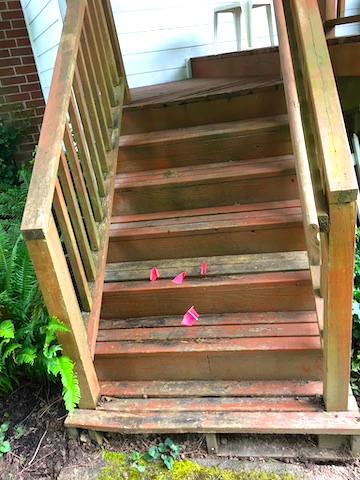
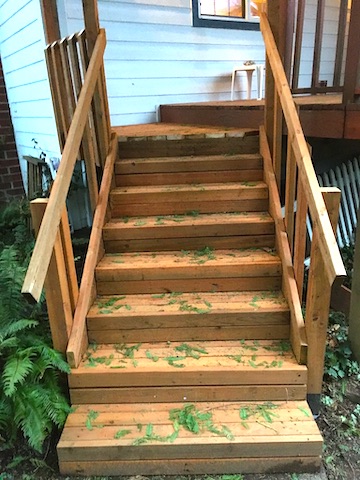
My mother in law walked down a broken stairway for sixteen years.
I’d replaced treads and firmed up the handrails, but we still joked about it.
“An independent observer might think my son in law is trying to kill me by falling through these steps,” she laughed.
“If the fall doesn’t kill you, my snake farm underneath them will,” I smiled.
I’m glad to say she didn’t fall and die on the steps. Or the snake farm.
Replacing steps is a big job with big questions, beginning with ‘Why didn’t I take more shop classes in high school.’ We had mandatory shop classes in eighth grade, if I remember right. Half a year of shop, half of Home-Ec.
I’m that many years old.
Since then I’ve bought and sold a table saw, drill press, router table, and radial arm saw; built beds, frames, boxes, and shoji screens. Did I learn my limits? Come on.
I started replacing the stairway with confidence that it would be a straight up remove and replace deal, just buy the same parts and screw them all together. Easy, right?
What I failed to notice in my vision of simplicity was I had to make my own stair parts, the runners and skirts and treads and risers. Which brings up my next big question:
Would Shop Class Fix A Broken Stairway?
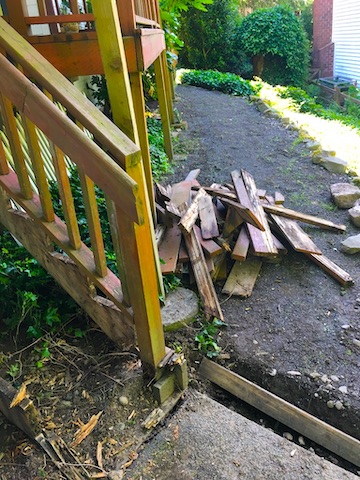
Education supporters call to bring back shop class. It’s a good idea, but what about shop class for adults? It’s never too late to learn how NOT to cut off a finger.
The table saw I bought had already scored one finger from the original owner. It tried for mine when I didn’t use a push-stick.
Some schools do have shop class with real shop teachers, not like the college classes taught by community guys with a large enough following to fill a room, and I have the distinct privilege of knowing one such shop pro.
I met Al in teacher class. Now he’s a teacher and I’ve got an inside line on shop stuff since he knows how to do tricky things. I wish I had asked him which saw was appropriate for replacing a broken stairway, but I didn’t, so I’ll make the call:
Use a chop saw as the main cutter, not a hand saw, powered or not. Sure you’ll do hand saw work cutting the big pieces, but chop the rest.
Use A Pattern
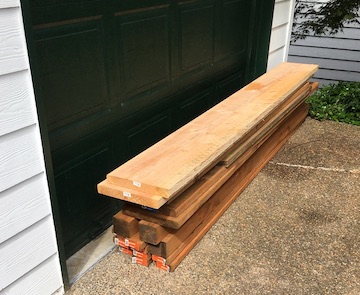
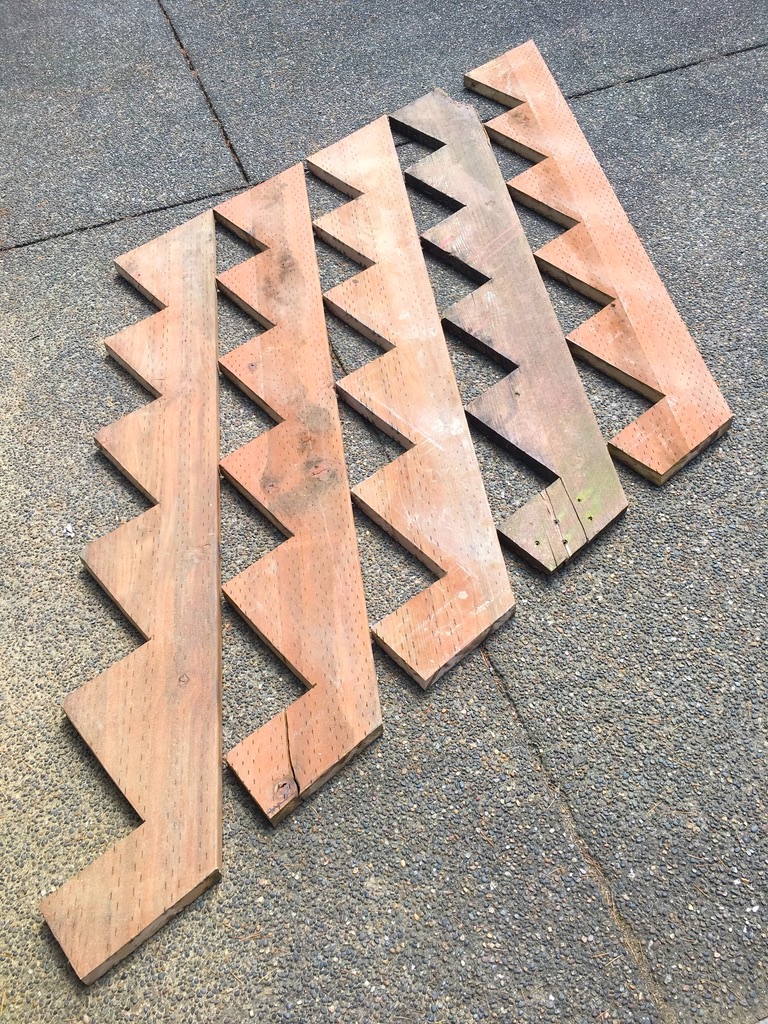
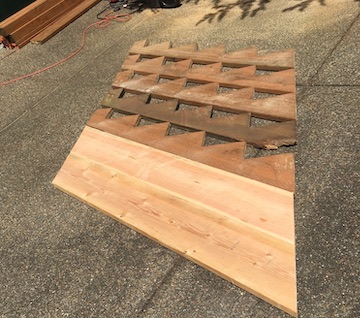
Don’t reinvent the wheel, chopper. Stair runners are pre-cut in the wood store, but they only go so high. Any higher and you pick out some nice pressure treated twelve foot 2×12’s.
To avoid complications, use the old runners for a pattern to mark the new wood. If they look sketchy, too rotten, buy a three step pre-cut from the store and use it as pattern, marking and moving it until you’ve got enough steps.
That’s a pro move I learned at the wood store.
Clean up all the inside angles for a tight fit. Since you’ve already torn out the old steps, pack the new runners and skirts to the site. Screw the sides together, stand back and marvel that they fit, then bolt them where the old stairs were. Easy enough so far?
Adding up the support dimensions, the runners and skirts on each side equal four inches thick, so is the doubled up center runner on this four foot wide span. Four feet doesn’t sound so big on paper, but it’s wide enough for irregularities to make a difference, like warped wood.
Avoid Past Failure
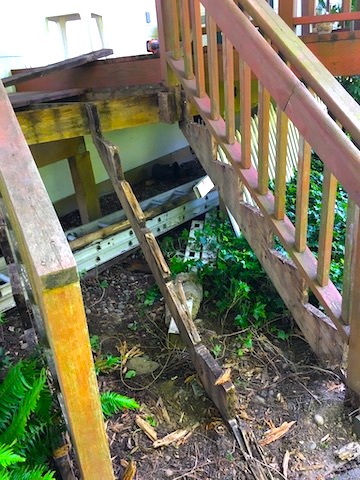
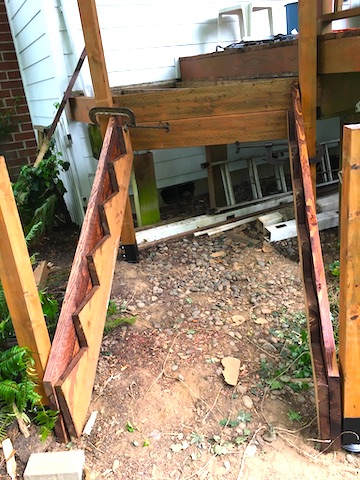
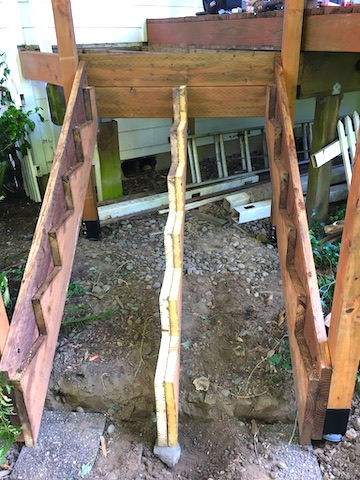
The old steps failed because the builder didn’t use outdoor wood, and there was ground contact. I avoided past failure by using four metal post anchors to support the step instead of anchoring to the top only, and cement pavers at the bottom.
Before driving the anchors four feet into the ground, call for utilities detection. Even though my guy marked an irrigation line as a gas pipe, it’s better to know than not know.
Cut one foot of 4×4 and fasten it into the post anchor. Warm up your arms because you’ll pound that 4×4 to splinters by the time you’re done. But first, before you break ground, recheck the measurements.
If you don’t carry the same width from top to bottom, the spread will either gap the tight tread fit, or you endlessly trim each piece using every curse word twice.
Angled Stairway, Special Hell, Agile Recovery
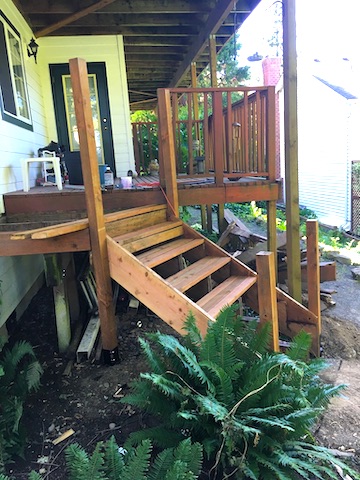
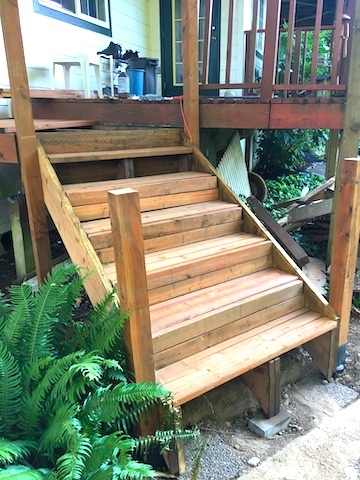
After you screw the runners and skirts together, hang them with metal stair hangers at the top. Add more steel where there’s contacts. To get it just right, clamp them to the posts, then do the connecting.
If you mis-measured and one post is closer than the other? Continue. The key at this point is leveling the two sides and center so the treads hit them all flat.
The chop saw removes some variables at this stage and saves a ton of time. With a skill saw you measure, mark, then draw a line with a square and hope you keep it close and not tail off at the end; with a chop saw it’s measure, mark, cut. I should have called Al.
After all of the cutting and clamping and hanging and screwing, after dabbing wood preservative on the raw cuts, the rotten steps are gone. But the same conditions that did that job also did it to the deck section the steps attach too.
As long as you’re there, replace that too. Cut and gap the floor until you get to the angle where the stairway goes down. Do you panic, regret thinking shop class was a waste of time, or do you channel your inner Mr. Hudson and Mr. Snoddy and figure it out?
If you panic, take a deep breath and place a piece of floor wood long enough to hang over the angle and mark it underneath with your big, flat, shop pencil. Adjust the chop saw to fit the angle and cut. Do it all the way across knowing you’ll have about 1/16th of inch of play to match in front and not leave an ugly gap at the square end.
Recap On A Broken Stairway
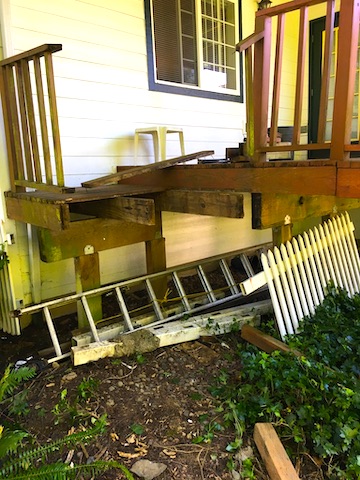
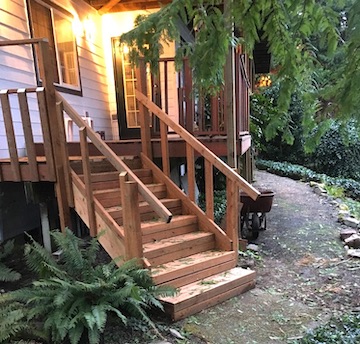
First, thank you for reading. I hope you found this post helpful. And thank you for being part of a BoomerPdx blogging experiment.
Yesterday I used the same broken stairway replacement idea as a metaphor for building trust and communication after the statues on the Portland South Blocks came down and the Oregon Historical Society took a hard hit.
One reader hit the link I posted on Facebook and twitter. I like to think I know one reader who looks for more than the usual, the standard, the cute. Maybe the broken stairway hit a nerve? Breaking into the history museum hit a nerve with me.
Subscribe to boomerpdx for more insights. You have my permission to copy and paste this link in your networks. I hope you do.


